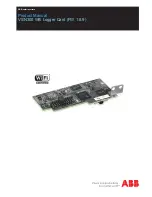
HOBO Pendant MX Temp (MX2201) and Temp/Light (MX2202) Logger Manual
1-508-759-9500 (U.S. and International) 7
www.onsetcomp.com
1-800-LOGGERS (U.S. only)
Insert the other logger mounting tab into the boot,
making sure the logger is securely seated in the boot as
shown.
•
To mount the logger in a boot to a small pipe, use two of
the cable ties included with the boot as shown.
•
To mount the logger in a boot to a large pipe, use one of
the cable ties included with the boot as shown.
•
To mount the logger in a boot to a flat surface, use two
#8 screws as shown. Do not overtighten the screws.
Other Deployment Guidelines
•
When deploying in water, the logger should be
appropriately weighted, secured, and protected
depending on water conditions and desired
measurement location.
•
Loggers deployed in direct sunlight heat up so that
temperature readings are warmer than the ambient
temperature. Use a solar radiation shield to ensure
temperature readings represent the ambient
temperature.
Attach the logger to a solar radiation shield (RS1 or M-
RSA) using the solar radiation shield bracket (MX2200-RS-
BRACKET). Attach the logger to the underside of the
mounting plate as shown in the following example. For
more details on the solar radiation shield, refer to the
Solar Radiation Shield Installation Guide
at
www.onsetcomp.com/manuals/rs1.
Note:
To log both
temperature and sunlight, you need two MX2202 loggers.
Place one logger in a solar radiation shield to log
temperature and the other mounted flat on top of the
solar radiation shield to record sunlight.
•
When measuring light intensity outdoors or underwater,
make sure the MX2202 logger is mounted horizontally so
that the light sensor is pointing straight up towards the
sky as shown in this example.
•
Be careful of solvents. Check a materials compatibility
chart against the wetted materials listed in the
Specifications table before deploying the logger in
locations where untested solvents are present. The
logger has an EPDM O-ring, which is sensitive to polar
solvents (acetone, keton) and oils.
Maintaining the Logger
•
To clean the logger, rinse it in warm water. Use a mild
dishwashing detergent if necessary. Do not use harsh
chemicals, solvents, or abrasives.
•
Periodically inspect the logger for biofouling if it is
deployed in water and clean as described.
•
Periodically inspect the O-ring on the inside of the
battery cover for cracks or tears and replace it if any are
detected (MX2201-02-ORING). See
Battery Information
for steps on replacing the O-ring.
Protecting the Logger
Note:
Static electricity may cause the logger to stop logging.
The logger has been tested to 8 KV, but avoid electrostatic
discharge by grounding yourself to protect the logger. For more
information, search for “static discharge” on
www.onsetcomp.com.


























